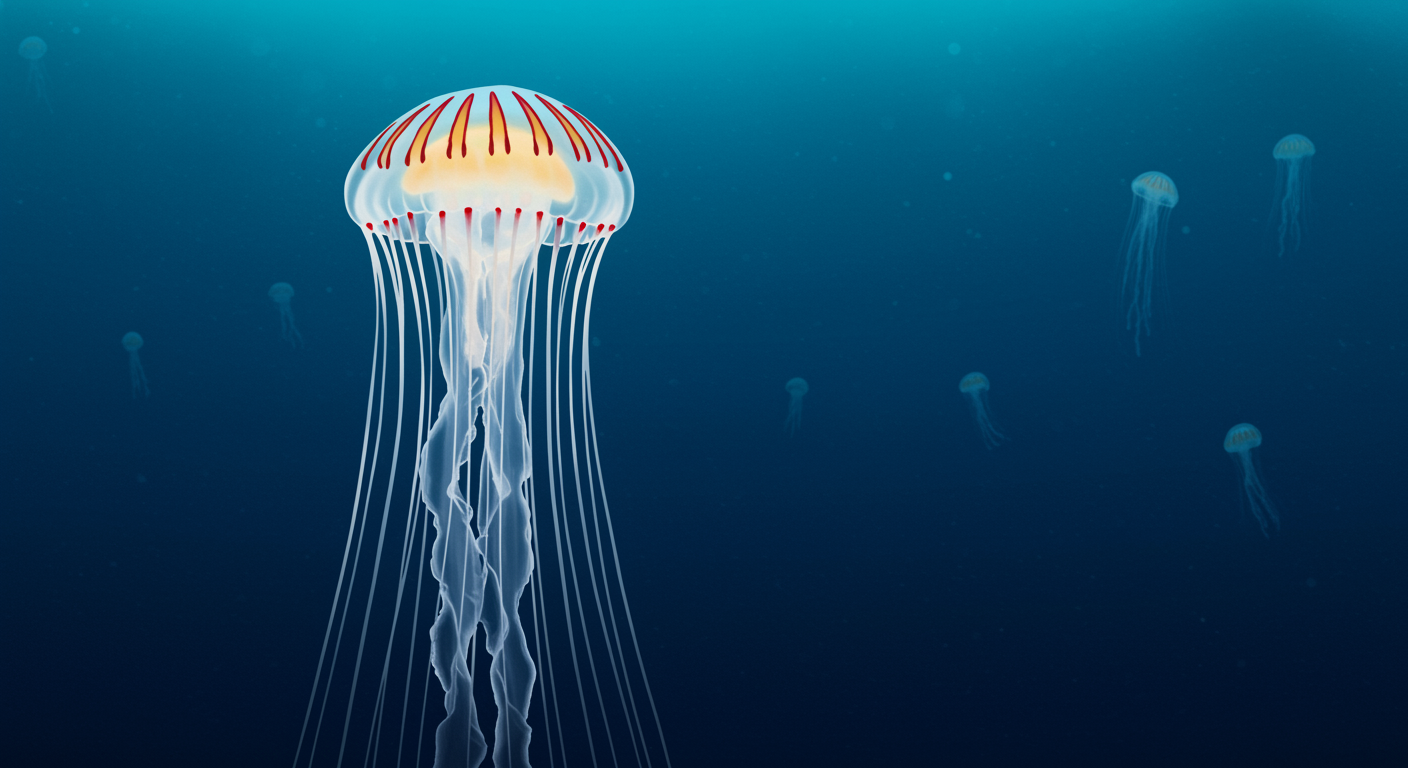
Getting older doesn’t have to be a linear journey. A tiny jellyfish species can reach adulthood, face a significant threat, and simply choose to turn back the clock, reverting to an earlier, juvenile stage. For most life forms on Earth, aging is an irreversible process, a march forward from birth to maturity to eventual decline and death. Yet, in the vast expanse of our oceans, this organism challenges a fundamental biological rule, offering a glimpse into a very different kind of existence.
This organism is a particular species of jellyfish, scientifically known as Turritopsis dohrnii. It’s often referred to as “the immortal jellyfish,” a label that, while not entirely precise in the common sense, certainly hints at its extraordinary capabilities. While individual Turritopsis dohrnii can indeed be consumed by predators or fall victim to disease, this species possesses a unique biology that allows it to repeatedly avoid death by aging, resetting its life cycle when conditions demand it.
To appreciate this feat, let’s briefly consider a typical jellyfish life cycle. It generally begins as a tiny larva called a planula, which settles on a suitable surface and develops into a sessile polyp colony. These polyps then bud off genetically identical medusae – the free-swimming, bell-shaped creatures we commonly recognize as jellyfish. For most species, these medusae mature, reproduce, and then naturally senesce and die. For Turritopsis dohrnii, however, if it encounters environmental stress, such as starvation or a sudden change in water temperature, or if it sustains a physical injury, it can initiate a remarkable process called transdifferentiation.
Instead of succumbing to these pressures, its adult cells revert. The medusa’s bell folds inward, its tentacles retract, and it sinks to the seafloor, effectively transforming back into a polyp. This isn’t merely regeneration, where a lost limb might regrow, as seen in starfish or salamanders. This is a complete cellular overhaul, a true biological reset. Specialized adult cells (like those forming muscle, nerve tissue, or the bell itself) lose their differentiated identities. They then reprogram themselves, becoming pluripotent once more, capable of developing into any cell type required to form a new, genetically identical polyp colony.
Think of it in an analogous way: imagine a fully grown adult human transforming entirely back into an embryo, retaining its genetic information but shedding its accumulated age and specialization. While imperfect, this comparison helps illustrate the profound nature of what Turritopsis dohrnii achieves. Its ability to switch off aging and revert to an earlier developmental stage is a phenomenon that has captivated the attention of biologists globally since its discovery.
The initial observations of this phenomenon date back to the early 1990s. Scientists in Italy, specifically Ferdinando Boero and his team, first documented this reversal capacity in a laboratory setting. Later, independently, Shin Kubota in Japan embarked on decades of dedicated research, meticulously studying and documenting the various cycles of reversal and rebirth within his laboratory colonies. These pioneering studies confirmed that the jellyfish could perform this trick not just once, but multiple times, creating what amounts to an indefinite life cycle under optimal laboratory conditions. Kubota has famously maintained colonies for years, continuously observing them age, revert, and grow again.
The cellular mechanics behind this reversal involve significant changes in gene expression and cellular reorganization. It appears that the jellyfish activates specific genes while suppressing others, effectively turning back its cellular developmental clock. Researchers are working to identify the precise molecular signals and genetic pathways that govern this extraordinary plasticity. Understanding how adult, specialized cells can de-differentiate and then re-differentiate into an entirely different life stage presents immense opportunities for stem cell research and regenerative medicine. It suggests that the aging process, which we largely consider unidirectional, might contain mechanisms for reversal that are simply dormant in most other complex organisms.
While the capacity for rejuvenation is intrinsic to Turritopsis dohrnii, it is typically triggered by adverse environmental conditions. A sudden shift in water chemistry, a scarcity of food resources, or physical damage can prompt the adult medusa to begin its transformation back to the polyp stage. This survival strategy has proven remarkably effective, contributing to its resilience. Furthermore, this unique ability, combined with its small size (it’s only a few millimeters in diameter) and its capacity to spread through global shipping ballast water, has led to its increasing presence in various oceans around the world.
The biological reversal demonstrated by Turritopsis dohrnii presents a profound challenge to our conventional understanding of life, death, and the aging process. It reminds us that nature often holds answers to questions we haven’t even fully formulated yet. This tiny jellyfish isn’t merely a biological anomaly; it functions as a living experiment in cellular plasticity, a master class in biological resilience played out repeatedly in the ocean’s depths.
Studying how this organism manipulates its cellular clock could provide fundamental knowledge about cellular programming and senescence. It compels us to consider the inherent flexibility of biological systems and the untapped potential residing within living cells. What specific signals initiate this cellular reset? What secrets might its genes hold about controlling cellular aging or guiding development in a reverse direction? The jellyfish that can repeatedly revert to its infant state continues to prompt new avenues of scientific inquiry, making us rethink the very limits of life itself.